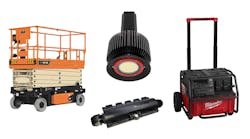Despite the long history of development and use of high-intensity discharge (HID) lamps, many in the industry expect that they will soon become extinct, given the rapid growth of light-emitting diode (LED) street and area lighting products. Nevertheless, manufacturers continue to design and market new types of HID ballasts with higher electrical efficiencies and lamps/fixtures with higher luminous efficacies.
Given their low efficiencies and strain on natural resources and inability to be electronically controlled, magnetic HID ballasts will inevitably soon be left behind. They just don’t have much to offer in terms of lighting control for the smart grid. However, they have served as a vital stepping stone to new HID ballast technologies, which, in turn, have led to new HID lamp technologies.
Magnetic HID Ballasts
From the early HID lamps to those used over the past 25 years, the operation of HID lamps has been successfully accomplished using a specially designed “transformer” called a magnetic HID ballast. Many lighting professionals simply call this a core and coil ballast. Losses in an inductive ballast are caused by its resistance and magnetic core. Their losses may be significant — on the order of 5% to 25% of the input electric power to the lamp. For a lower wattage HID lamp of 39W, losses are small. However, a 400W metal-halide ballast can have losses of about 65W — or roughly 13.9% of rated lamp power. With millions of lossy magnetic HID ballasts still on the grid, the motivation for replacing them with electronic HID ballasts is there.
The use of an inductor has been very common in line-frequency ballasts to provide the electrical condition for proper lamp starting and operating to power HID lamps. A disadvantage of the inductor is that current is shifted out of phase with the voltage, producing a poor power factor on the AC line.
For large lamps, line voltage may not be sufficient to start the HID lamp, so an autotransformer winding is included in the magnetic ballast to step up the voltage. The autotransformer is designed with enough leakage inductance so that the current is appropriately limited.
Because of the large inductors and capacitors that must be used in magnetic HID ballasts, reactive ballasts operated at line frequency tend to be large and heavy, making them costly to ship and difficult to install. Ballasts with a rating of 400W and higher are extremely heavy. It’s not uncommon to mount these heavy ballasts remotely from the lamps. However, remote mounting adds capacitance to the ballast output, which affects the operation of HID lamps.
Soon after electronic loads started to appear on the grid, electric utilities realized that the characteristics of the AC line currents (see SIDEBAR: One Size Doesn’t Fit All below) required by loads like electronic and magnetic ballasts must be managed at the load. Designers of end-use equipment began to look at simple passive methods to reduce harmonic currents. Before non-linear electronic loads proliferated across the power system, equipment designers were experimenting with simple tuned LC circuits to reduce low order harmonic current like the third and parts of the fifth, seventh, and ninth. Designers of magnetic HID ballasts also made design changes to lower the harmonic current flow on the AC line input and raise the power factor. These changes had a few things in common — they added cost and weight to the product and decreased energy efficiency.
In more expensive magnetic HID ballasts, a capacitor is often paired with the inductor to help correct the displacement power factor. (The displacement power factor is a measure of the shift between the voltage and current waveforms. In a resistive load where the power factor is unity, the voltage and current line up with each other.) However, the magnetic ballast designer is forced to select a discrete value for the capacitor based on the inductance of the inductor to provide a sink in an LC circuit for the largest harmonic current. With this, reduction of the other harmonic currents in PFC-corrected magnetic HID ballasts is limited, so the displacement power factor can never reach unity.
Despite their drawbacks, magnetic HID ballasts have served as the “iron bridge” to a newer, more promising technology — the electronic HID (eHID) ballast. Advancements in HID lamps took place because so many magnetic HID ballasts are currently connected to the grid. Today, HID lamp research continues in an effort to develop more efficient lamps that render colors better, last longer, and offer better dimming performance.
Electronic HID Ballast Technologies
Lamp manufacturers helped spawn the movement to design eHID ballasts by developing HID lamps for specific use with eHID ballasts. In addition, approval by manufacturers to dim some HID lamps also stimulated growth in designing and manufacturing eHID ballasts with dimming capabilities.
Analog eHID ballasts. The first commercially available eHID ballast was designed and manufactured in about 1993. It was an isolated ballast (meaning it used a primary-secondary type of output inductor to interface to the lamp) and was designed to replace the 400W magnetic HID ballast. It used a sine wave-based driving current at a switching frequency around 100 kHz. Its claim to fame was that it was the first eHID ballast that could drive an HID lamp without initiating the common problem called acoustic resonance associated with using high-frequency current to drive HID lamps. (Acoustic resonance is a condition that can be set up in the arc tubes of HID lamps that allows pressure waves to be set up in the tube based on the use of certain driving frequencies.) When acoustic resonance occurs, the arc tube will reach a point where it will erupt, possibly causing the outer glass envelope of the HID lamp to explode.
Design of control systems needed for eHID ballasts presented additional challenges for ballast designers. Early eHID ballasts provided ballast and lamp control using discrete electronic devices. It was not uncommon for an analog-based eHID ballast to use as many as 50 components just for ballast and lamp control. However, development of integrated circuits (ICs) for HID ballast control made eHID ballast designs much more achievable and economical for ballast manufacturers. With the use of dedicated eHID ballast controls, component counts dropped, and ballast/lamp control improved.
Figure 1 (click here to see Fig. 1) illustrates a simplified block diagram for today’s most popular eHID ballast design, which is made up of four basic sections:
- AC line input,
- Bridge rectifier and active power factor correction (APFC),
- Electronic inverter, and
- Output impedance network.
The AC line input section provides different types of protection against internal and external threats to the operation and life of the ballast. It is customary for electronic ballasts today to include overtemperature protection for the ballast (and fixture). If, for any reason, the ballast starts to overheat, the overtemperature protection device (typically in line with the AC power conductors) will present as an open circuit and shut off the ballast. Overtemperature protection is typically provided by the use of one or two AC line input fuses.
Overvoltage protection is provided by a surge protective device (SPD). Research at EPRI shows that overvoltage protection is vital to the safe operation and long life of eHID ballasts. However, not all manufacturers use the same type or level of overvoltage protection in their ballasts. Any overvoltage protection device should not operate unless there is a definite need to protect the ballast or the environment where the ballast operates. False operation of overvoltage protection devices creates nuisance problems for end-users. When an HID lamp goes out, it presents a light outage to the customer, regardless of why the lamp went out. Metal-halide lamps must endure a cool down period before they can be re-ignited, so avoiding false lamp outages is critical to keeping the lights on.
EPRI research also shows that overprotection devices must work together in coordination to be effective. Coordination is achieved by considering the time effects of these devices. For example, when a surge occurs as a result of a nearby lightning strike, the SPD must provide surge protection for the ballast without causing the AC line fuse inside the ballast to open. If a surge occurs and triggers the SPD to protect the ballast electronics and the fuse blows, then the customer ends up with a failed ballast.
eHID ballasts generate high levels of emissions like other end-use equipment using electronic power supplies. If emissions are not controlled, there is a higher probability that end-users will experience electromagnetic interference (EMI) problems in their facilities. Electronic ballasts have been known to cause a variety of EMI problems, but improvements in devices designed to provide EMI control have reduced the number of EMI problems caused by electronic lighting products.
The second section of the diagram is the bridge rectifier and active power factor correction (APFC) block. Electronics in this section corrects for both types of power factor — displacement and true. Chip manufacturers now provide APFC controllers. This is a significant improvement in ballast design as compared to using a large, bulky AC-rated capacitor to correct only displacement power factor. With the use of APFC in eHID ballasts, the reactive power requirement is much smaller.
Any lighting installer will tell you that multi-voltage magnetic HID ballasts must be wired carefully during installation. Multi-voltage magnetic ballasts ranging from 120V to 277V have a separate AC conductor for each AC line voltage. The primary disadvantage of having multiple conductors to choose from is the likelihood of picking the wrong one during installation. Most eHID ballasts provide universal voltage inputs — one of the by-products of using APFC circuits in electronic ballasts. EPRI research shows that most power quality problems are caused by wiring and grounding errors inside customer facilities. Thus, having only one AC line conductor to choose from when wiring an eHID ballast will prevent power quality problems and increase customer satisfaction.
The major advantage of using eHID ballasts over magnetic HID ballasts relates to the electronic inverter section. Early eHID ballasts were not dimmable, but most of the eHID ballasts available today provide that option. In addition, the use of integrated controls in the inverter section can provide advanced lamp control. The lamp startup process for an HID lamp is complex. Advanced lamp startup can help lengthen the life of HID lamps.
The last section in an eHID ballast is the output impedance network. The impedance of the inverter section must be matched to the impedance of the lamp. Most eHID ballasts use isolated networks. Non-isolated networks provide direct connection between the inverter and the lamp.
With the improvements now available in digital signal processors (DSPs), some eHID ballast manufacturers are moving toward the use of DSPs in their digital eHID ballast designs.
Advantages of DSPs
There are hundreds of benefits for using DSPs to operate eHID ballasts. The general advantage is that ballast and lamp control is not limited. In an analog ballast, changing a control function requires changing a physical component, which requires changing the printed circuit board. In a digital ballast that uses a DSP, changes to ballast and lamp control can be made by making changes to the programming code and then reloading the code into the ballast. Changes to the code can even be made remotely after the fixtures have been installed in a customer’s facility.
Analog vs. digital control. In an analog-based eHID ballast, control over the ballast and lamp is achieved using continuous waveform signals. Analog signals are passed from one section of the ballast to another. One would think that continuous analog control would be the best control for any electronic load. However, with analog control, time constants must elapse before control decisions can be made. In digital control, point-by-point control can be achieved on the fly in a fraction of a second. In fact, control decisions can be achieved at very high speeds. This is very beneficial to the startup, operation, and shutdown of HID lamps. With digital control, some lamp and ballast conditions can be predicted before they occur. Many advanced control schemes can be employed using DSP control that cannot be achieved using analog control for HID lamps. Figure 2 (click here to see Fig. 2) illustrates a simple block diagram for a DSP-based eHID ballast.
Using DSP-control for AC line input sections. While the quality of AC power to electronic loads is improving, the threats presented to electronic loads are still very real. Power quality in any electric utility service territory and in any customer facility is constantly changing. Electronic loads are appearing in a customer facility every day. Any electronic ballast must be able to respond to changes in the quality of the AC line voltage at the ballast input. AC line input conditions can be monitored by the DSP to provide condition data to the DSP and to other systems outside of the luminaire. In many cases, a DSP can be “taught” to predict conditions at the AC line input before they occur (or become too severe) and make decisions regarding lamp and ballast control.
One key example is the occurrence of a voltage sag at the AC line input that can certainly present an AC line voltage low enough to extinguish the lamp. While every condition characteristic of a decreasing AC line voltage will not result in a voltage sag deep or long enough to cause an HID lamp to extinguish, adjustment of ballast and lamp control when AC line voltage starts to fall can be used to keep the lamp on until the sag is over. EPRI research indicates that sags, which are responsible for extinguishing millions of HID lamps per year, are the most commonly occurring non-destructive electrical disturbance on the grid.
Using DSP Control for APFC Section
On-the-fly decisions must be made to keep the true power factor as close to unity as possible. With an HID lamp as the load, the load presented to the APFC section from the inverter is dynamic. Physically bumping an HID lamp causes fluctuations in the ballast load. From the initiation of the arc inside the discharge tube to shutdown of the lamp, the lamp load is changing. Lamp load also changes as the lamp ages, but these changes are more gradual. The duty cycle for the switching inside the APFC section changes when the ballast load changes. Some APFC designs provide for changing switching frequencies based on load conditions. Use of DSP control for an eHID ballast can add layers of control to the APFC section. Coordination not possible (or limited) with analog ballast control between the APFC section and the inverter can be achieved when DSP control is used.
A DSP can also be programmed to change operating conditions when steady-state voltage quality conditions, such as voltage distortion, occur. Voltage distortion (Vthd) occurs constantly on the grid. Vthd is a part of normal grid operations, caused by distorted line currents flowing through the power system drawn by non-linear (i.e., electronic) loads. Vthd typically ranges from 1% to 2%, but can reach higher levels. IEEE 519, IEEE Recommended Practices and Requirements for Harmonic Control in Electrical Power Systems, places a limit on Vthd for different voltage classes at the point-of-common-coupling (PCC). One example of a PCC is where service entrances come together at the secondary of a electric utility service transformer. For example, for general distribution systems with voltage greater than 120V and 69kV RMS with a ratio of ISC to IL, Vthd must be less than 5%. (ISC is the maximum short-circuit current at the PCC. IL is the maximum demand load current at the PCC.)
In 2010 and 2011, EPRI investigated two cases in different electric utility service territories where Vthd was greater than 5%. One case involved many 1,500W metal-halide magnetic HID ballasts failing to start their lamps at a high-school football stadium. The Vthd at the PCC reached levels as high as 13%. Some lamps would fail to ignite while others would fail to reach maximum light output after ignition.
Using DSP Control for Electronic Inverter Section
Critical lamp and ballast decisions to keep the lamp running in a safe and reliable way must be made in the electronic inverter section. Each control decision will have an impact on the magnitude and shape of the voltage and current reaching the lamp. Under point-by-point digital control when a DSP is used, the ballast can alter control of the lamp in less than a few millionths of a second.
One example of enhanced lamp control is determining the optimal ignition voltage to re-strike a lamp and lamp re-strike time for an HID lamp that was extinguished during a power outage. Metal-halide lamps typically require a re-strike time between 7 minutes and 15 minutes. With DSP control, re-strike time can be dynamic and specific to the estimated temperature of the lamp and its surrounding environment at the time the discharge was extinguished. DSP ballasts are allowing eHID ballasts to achieve re-strike times as short as 2 minutes. DSP control can also provide for a starting voltage higher than 4kV, if needed to achieve re-strike.
One of the prime advantages of using DSP technology to provide intelligent control to HID lamps is seen with how lamps are dimmed. Lamp dimming is dynamic. If not accomplished according to correct lamp seasoning and lamp startup practices, the life of the lamp will be shortened. Analog-based dimmable eHID ballasts typically provide continuous lamp dimming across a wide range of lamp power. Some dimmable eHID ballasts can dim HID lamps down to about 30%. However, with analog ballasts it is more difficult to achieve dynamic dimming.
An eHID ballast with DSP control can even be programmed to determine which type of HID lamp the ballast is connected to. Today, each ballast manufacturer must maintain a few hundred types of ballasts for each type and size of HID lamp used. Limits on the advantages of using DSP control in eHID ballasts are simply at the fingertips of the programmer.
Demand response (DR) is one area in energy-efficiency research where the availability of advanced intelligent DSP ballast control can really be put to use. Turning off specific fixtures and dimming lamps to specific light levels will be a requirement for customer facilities. The dimming function provided to one customer may not be that needed by another. Dimming can depend on time of day, weather conditions, and other factors not under the control of the customer. For example, specific sections of a warehouse may only be needed when stock is received into a shipping department when the shipping clerks work the shipments at night. When these sections are not needed, a signal from a wireless lighting controller can be sent to those fixtures, turning them off. However, during holiday seasons when the shipping clerks must increase their hours and work in the daytime to get the products onto the floor more quickly, the lights in the shipping department are needed but not at full brightness, because the space is located on the outside wall of the building where windows are located. A DSP-based eHID ballast can be programmed to provide these functions.
Keebler is a senior research engineer with the Electric Power Research Institute (EPRI), Knoxville, Tenn. He can be reached at: [email protected].
SIDEBAR: One Size Doesn't Fit All
Electronic HID (eHID) ballasts require higher levels of AC line current than electronic fluorescent ballasts and CFLs. With higher levels of line current, larger electromagnetic interference (EMI) filters are needed to control emissions. While magnetic HID ballasts must be larger to operate higher power lamps, there is less variation in their size. For example, 400W ballasts were essentially all the same size. However, one could purchase 12 eHID ballasts today from different manufacturers and quickly realize that size variation can present a problem to fixture designers and manufacturers. In fact, some eHID ballasts are way too large to be used in existing HID fixture designs.




